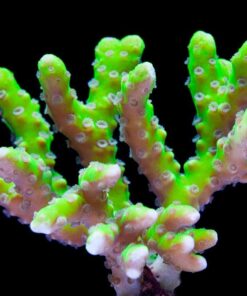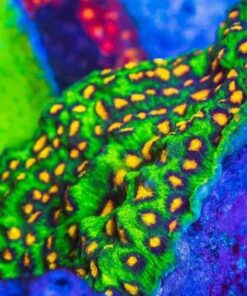Purple & Green Blastomussa wellsi
Q280.00
3 POLYPS
1 in stock
DESCRIPTION
Australian Big Polyp Purple/Green Blastomussa (Blastomussa wellsi) just like all other forms of Blastomussa Coral, would provide your aquarium with a wealth of texture and color, all the while asking very little from you in return.
The Australian Big Polyp Blastomussa Coral is commonly referred to as the Pineapple, Branched Cup or simple as the Blastomussa coral. This is a very passive coral, that does not have long sweeper tentacles and, which once established, is a moderately hard coral, this has given the Blastomussa Coral a great reputation for doing well in established reef aquariums that already has established coral colonies of other species.
The body of the Blastomussa Coral contains the symbiotic algae zooxanthellae from which it receives the majority of its nutritional requirements through photosynthesis. Note that the Blastomussa Coral benefits greatly from the addition of calcium, strontium, and other trace elements of the water.
Due to its resemblance to mushroom anemones, Blastomussa corals are often confused with other brain and mushroom corals.
The Australian Big Polyp Blastomussa Coral is commonly referred to as the Pineapple, Branched Cup or simple as the Blastomussa coral. This is a very passive coral, that does not have long sweeper tentacles and, which once established, is a moderately hard coral, this has given the Blastomussa Coral a great reputation for doing well in established reef aquariums that already has established coral colonies of other species. The fact that this coral requires a low water current and a moderate light level make it an ideal species for a home salt water aquarium.
The body of the Blastomussa Coral contains the symbiotic algae zooxanthellae from which it receives the majority of its nutritional requirements through photosynthesis. It does not require additional food to maintain its health in the reef aquarium, but it will feed on zooplankton or foods designed for filter feeding invertebrates. Note that the Blastomussa Coral benefits greatly from the addition of calcium, strontium, and other trace elements of the water.
This coral is a large polyp stony (LPS) coral that will form round, swollen discs when it grows. Due to its resemblance to mushroom anemones, Blastomussa corals are often confused with other brain and mushroom corals. Both of these corals will create a visual appeal in any home aquarium.
The Blastomussa Coral colonies are phaceloid to plocoid, and consist of a few to large numbers of corallites. Corallites that are less than 7mm diameter without long sweeper tentacles.
Note that this Australian beauty has extraordinarily large polyps, and grows in fused, tubular clusters in a similar manner to its close relative Blastomussa merletti. The majority of these corals were harvested in Australia, quarantined and given a health inspection before being exported into throughout the rest of the world.
Within the Blastomussa family there are only two subspecies, Blastomussa merleti and Blastomussa wellsi. The main difference in these two corals is the size of their polyp. It is very much of an undemanding coral, it has been known to grow as many as 5 additional heads within a 2 month period. All by applying a lot of tender loving care. This is mostly due to; coral bleaching, ocean acidification, climate change, over-fishing and habitat damage. Trade in the Australian Big Polyp Blastomussa was halted by the European Union in 2000 when the scientific basis of the export quotas for this species was questioned and is currently on review by regulators.
The fossil history of the Blastomussa genus dates back to the Pleistocene period which occurred approximately 1.8 million years ago. Molecular analysis of the Australian Big Polyp Blastomussa by Fukami et al. (2008) placed it in a clade with members of the Faviidae family (genus Plesiastrea) and Euphyllidae family (genus Physogyra and Plerogyra).
Be the first to review “Purple & Green Blastomussa wellsi” Cancelar respuesta
Related products
SPS
EUPHYLLIA
Montipora
Chalice
EUPHYLLIA














Reviews
There are no reviews yet.